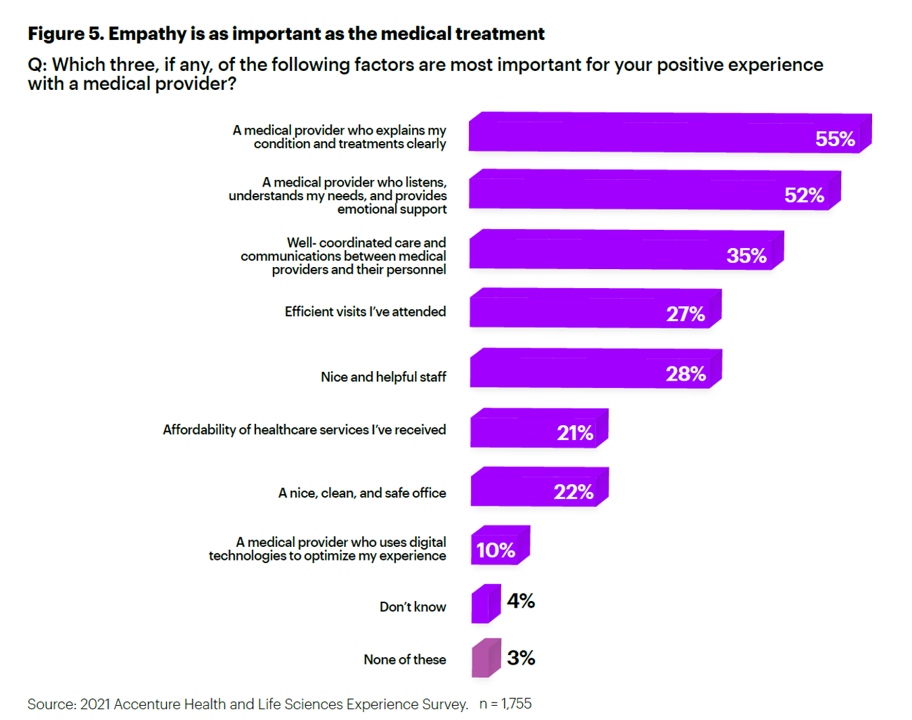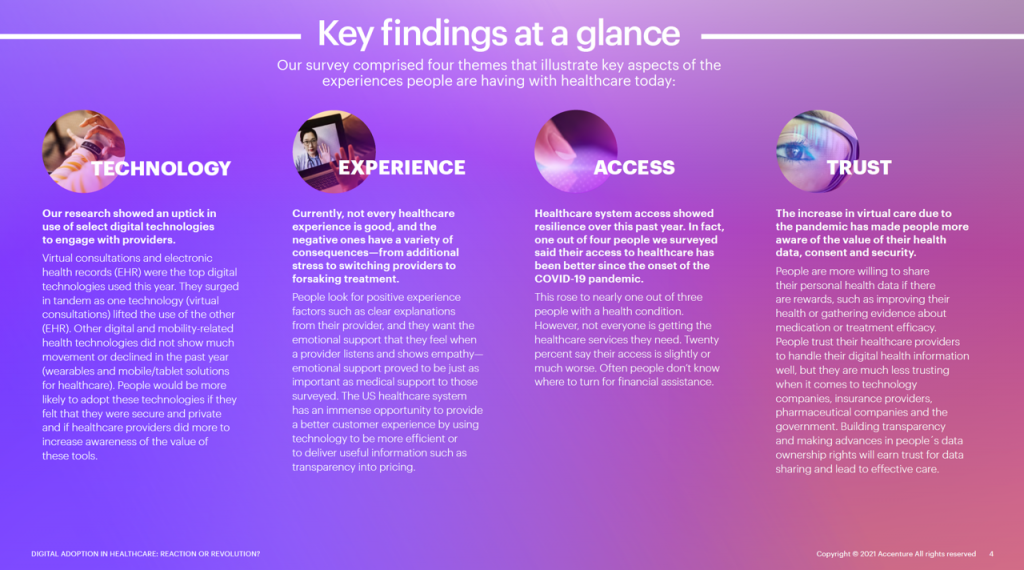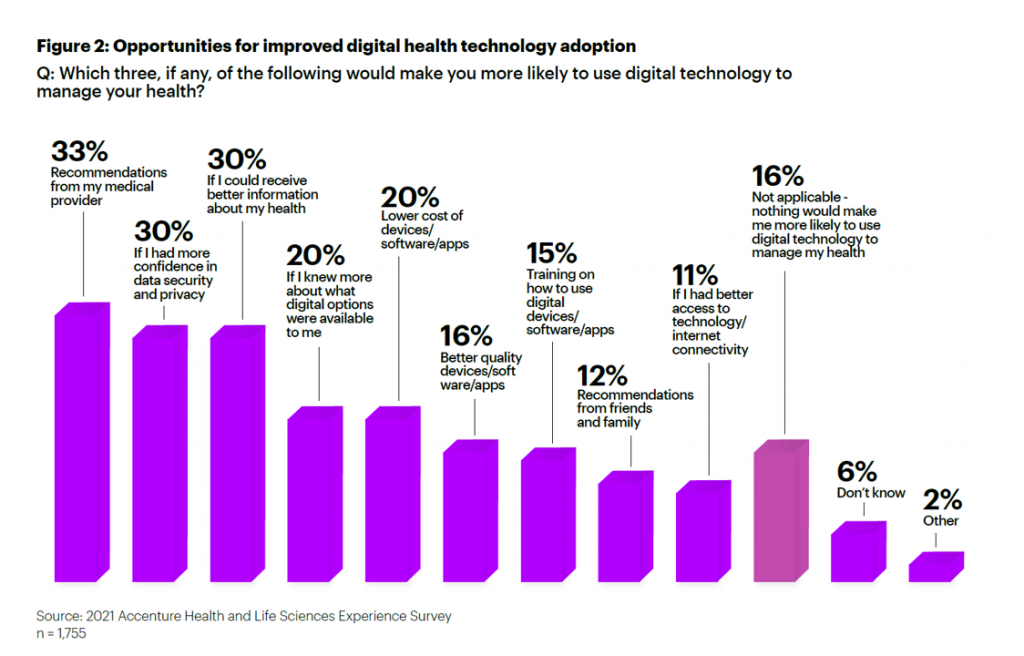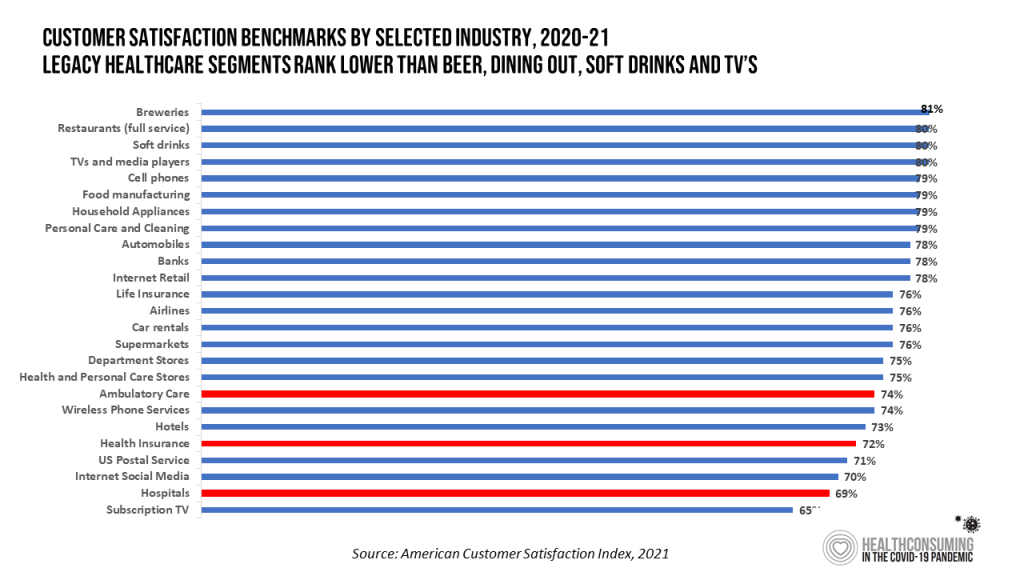The rise of digital health investment and growing role of technology in health care services only accelerated during the COVID-19 pandemic.
 At the same time, people took on their own versions of digital transformation at home, for work, for school, for cooking, shopping, and indeed, for health care.
At the same time, people took on their own versions of digital transformation at home, for work, for school, for cooking, shopping, and indeed, for health care.
But with digital health adoption gains has come some ambivalence and mixed signals, Accenture has discovered in its 2021 Health and life Sciences Experiences Survey released this week during the HIMSS Annual Conference.
As the report concludes, “people’s sentiments and behaviors” with respect to technology in health care “provide no clear answer.”
While the pandemic inspired a “reaction” in the words of Accenture in launching and expanding virtual health care, will this result in a “revolution?”
The answer: probably not, at least in terms of consumers’ mainstream adoption, unless the tech “support a more human healthcare experience.”
The first chart illustrates something attendees at #HIMSS21 as well as all health/care industry stakeholders should adopt as a mantra:
Empathy is as important as the medical treatment.
 Kaveh Safavi, Accenture’s Senior Managing Director, Consulting, Global Health will discuss these results at #HIMSS21 on 10th August.
Kaveh Safavi, Accenture’s Senior Managing Director, Consulting, Global Health will discuss these results at #HIMSS21 on 10th August.
When we consider empathy in health care, that’s a building block of trust — one of the four key themes that emerged from the consumer study, which also addressed technology, experience, and access:
- The top technologies consumers adopted in the past year were virtual consultations and EHRs — which in fact “surged in tandem” with telehealth lifting the use of health records.
- Consumer experiences (CX) were not uniformly terrific, especially with an increasingly anxious patient dealing with a stressed provider system.
- Not everyone in the U.S. received the health care services they needed, with one in 5 patients saying their access was worse in the past year. Access in this context doesn’t mean only physical or logistical access to services, but to financial affordability that can result in people self-rationing care.
- Finally, trust was the fourth aspect on U.S. health citizens’ minds, making people more aware of the value of their health data, privacy and security aspects.
 What builds empathy and trust, the first graphic from the study details, are medical providers who clearly explain a patient’s conditions and treatments, as well as that provider listening, understanding needs, and providing emotional support.
What builds empathy and trust, the first graphic from the study details, are medical providers who clearly explain a patient’s conditions and treatments, as well as that provider listening, understanding needs, and providing emotional support.
Furthermore, streamlined coordinated care, efficient visits, and “nice and helpful staff” bolster a positive experience with a medical provider, Accenture discovered.
“Making healthcare more human begins with a step in the patient’s shoes,” Rich Birhanzel wrote in Accenture’s Humanizing Healthcare blog in July 2021. Some work-flows that health care stakeholders can take on to walk in those consumers’ shoes could include:
- Giving people access to all of their health data and tools to understand it
- Address health disparities at the root of the problem to help make health and wellbeing equitable
- Use technology creatively to de-fragmented disjointed health experiences, and do so in personal and convenient ways
- Partner inside and outside of the legacy healthcare system to re-imagine health care through the standards of the best retail and consumer services
- Finally, blend digital, virtual, and face-to-face care to, in Accenture’s words, “provide effective, trusted and reliable services.”
At the HIMSS conference today, Dr. Adrienne Boissy, Chief Experience Office of the Cleveland Clinic, led a day of patient experience sessions that addressed a range of these issues and others. Unfortunately, ironically, those of us attending the HIMSS Conference virtually, digitally, could not access those sessions.
 Health Populi’s Hot Points: More U.S. health consumers found high satisfaction with retail health services in the past (pandemic) year, according to the latest J.D. Power consumer survey on pharmacy satisfaction. Key factors that drive health citizens’ appreciation for health care services under the “empathy” umbrella are feelings of respect, transparency in pricing, well-designed tools (like patient portals), and trustworthy information that “speaks” to people in personal, culturally competent and relevant, and health literate ways.
Health Populi’s Hot Points: More U.S. health consumers found high satisfaction with retail health services in the past (pandemic) year, according to the latest J.D. Power consumer survey on pharmacy satisfaction. Key factors that drive health citizens’ appreciation for health care services under the “empathy” umbrella are feelings of respect, transparency in pricing, well-designed tools (like patient portals), and trustworthy information that “speaks” to people in personal, culturally competent and relevant, and health literate ways.
In context, consumers find lots more consumer-love and empathy from their favorite brewery, full service restaurants, soft drinks, TV and cell phone manufacturers. I’ve red-highlighted the three legacy health care industry that ACSI studies every year, showing that ambulatory care, health insurance, and hospitals garnered lower customer satisfaction than the top industries. When we think “health care” in terms of consumer satisfaction in this study, the industry feels more akin to lower-scoring hotels, wireless phone services, and the U.S. Postal Service than to more consumer-enchanting sectors.
As “patient engagement” emerges as a top priority for U.S. health care, learning from and collaborating with industries outside of pure-play “healthcare” will be a winning strategy to better inform more engaging design and consumer adoption and persistent use of digital tools across the evolving omni-channel health care ecosystem.




 Thank you, Trey Rawles of @Optum, for including me on
Thank you, Trey Rawles of @Optum, for including me on  I was invited to be a Judge for the upcoming
I was invited to be a Judge for the upcoming  For the past 15 years,
For the past 15 years,